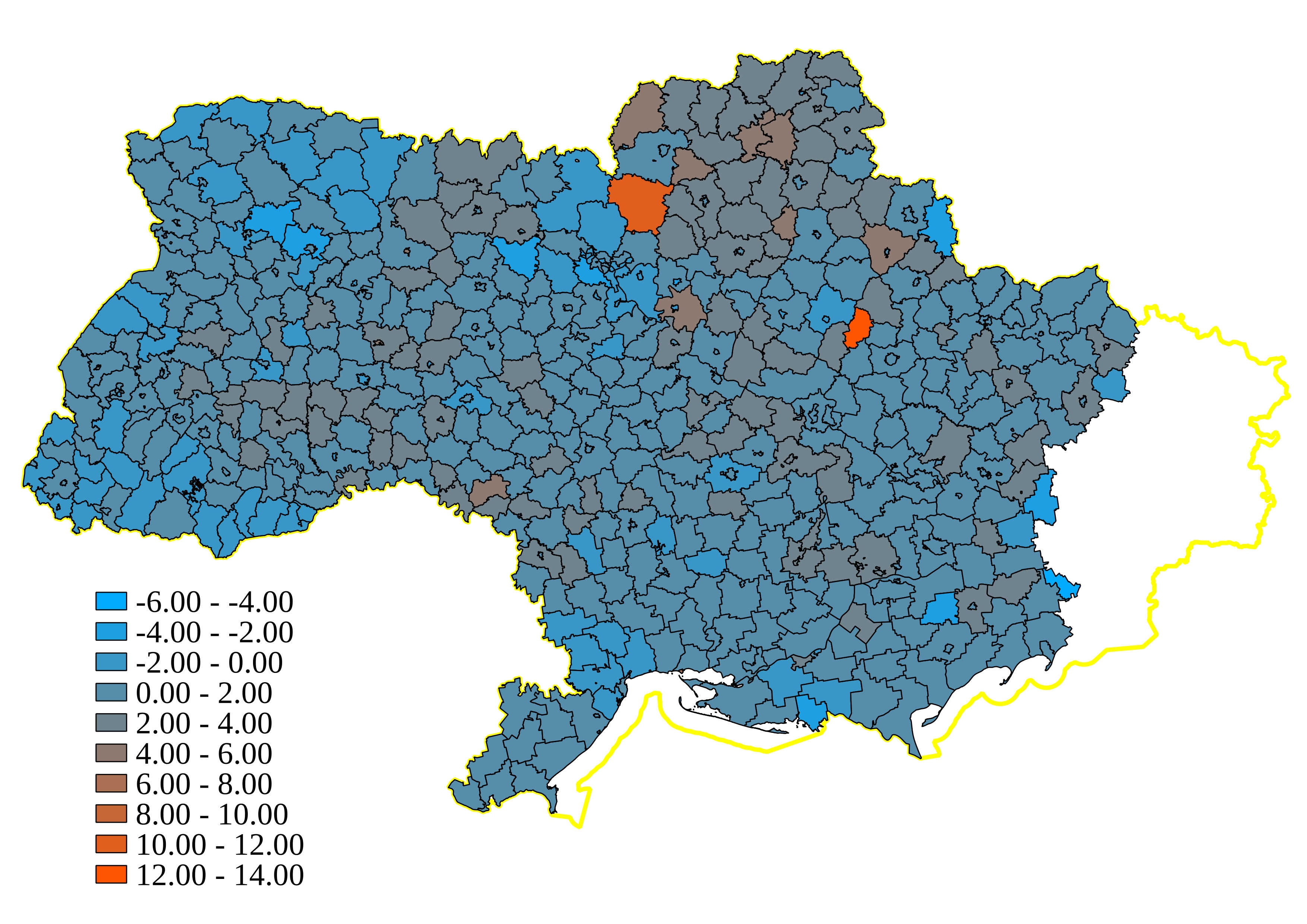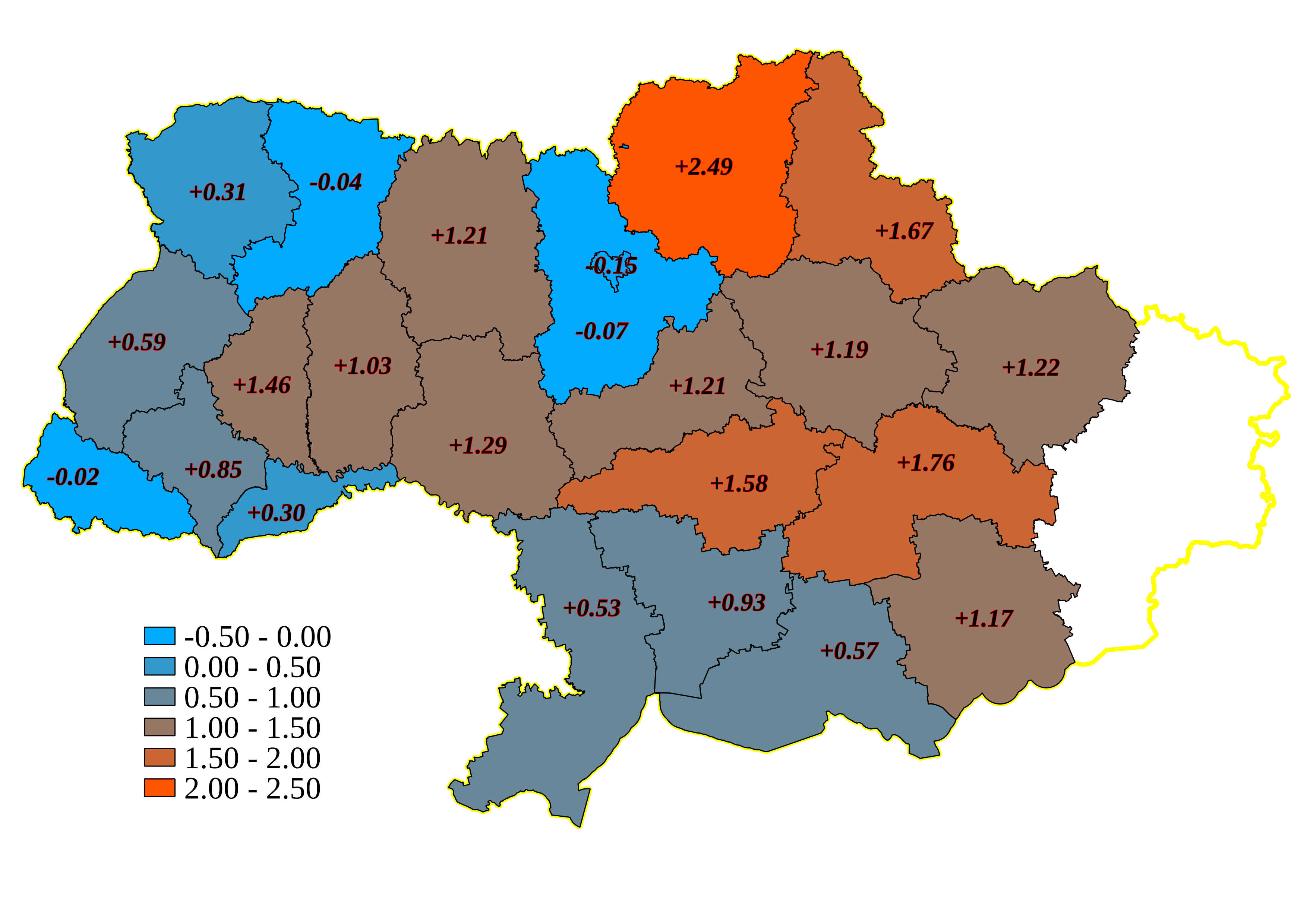The number of voters registered at a polling station is one of the basic indicators of electoral statistics. When this indicator is used in analytical handling of data on the course of election campaign, it's possible to find answers to various sociological, political, economic, and even cultural questions. Changes in total number of voters in regions, as well as voter turnout, show not only whether the election campaign was successful/unsuccessful. In fact, correlation of these indicators shows how active citizens are in civic and political sphere.
We researched how the number of voters registered in regular polling stations has changed for two election campaigns in 2014: early presidential election and early parliamentary elections in Ukraine. We used the data published on website of the Central Election Commission as the basis of research. We used the programming language R for analytical calculations, and the QGIS geoinformation system to create cartograms. Boundaries of administrative units and digital cartographic information were taken from the OpenStreetMap international project.
As long as the electoral administration is facing the certain difficulties in oblasts where the anti-terrorist operation is being conducted, we didn't use information on Luhansk and Donetsk oblasts. The available data on these oblasts is scarce and gives little information. The Autonomous Republic of Crimea is also excluded from the research, as long as it's impossible to conduct election campaign and voting there. The research covers 22 Ukrainian oblasts and Kyiv city - districts #11-40, 62-103, and 115-223 on early parliamentary elections in Ukraine.
To analyze the data on both election campaigns, we included them in a single table, which allows to study election districts of the presidential campaign within district boundaries of the parliamentary campaign. We used numbers of polling stations as unique identifiers. As long as the delineation of election districts is quite complicated and digital map of districts is not available, we used territorial administrative units of Ukraine to study how the number of voters changes. The table contains processed data summarizing indicators on two levels: raions and cities of oblast significance, Kyiv city districts (level I), oblasts and Kyiv city (level II). The final indicator is a relative change of the number of voters within an administrative unit, compared to 2014 presidential campaign.
The first level table contains 577 entries, so we don't publish it. However, a cartogram based on the results of calculations is available for your consideration.
The single table for both election campaigns contains 27,106 entries. The parliamentary election campaign has 35 polling stations less than the presidential campaign in 2014 had. There are 27,050 regular polling stations on parliamentary elections, compared to 27,090 on presidential. 27,044 polling stations which were functioning during presidential elections were selected for the comparison with regular polling stations open on parliamentary elections. The total number of voters in districts that were included in the sampling for presidential elections is 28,451,394. The districts included in the sampling for parliamentary elections had 28,709,267 voters. In general, according to the CEC, the number of voters in districts 11-40, 62-103, 115-223 (577 administrative units) has increased in 257873 persons (+0.91%). The maximum increase in the number of voters was noticed in Dnipropetrovsk city: 13,610 persons (+1.72%). The maximum decrease in the number of voters was noticed in Darnytskyi district of Kyiv city: 3,964 persons less (-1.42%). In average, the number of voters in 577 administrative units of Ukraine has increased on 447 persons. The maximum increase was noticed in Shyshatskyi raion of Poltava oblast: +13.41%. The second highest increase - Kozeletskyi raion of Chernihiv oblast: +10.13%. The maximum decrease of the number of voters was noticed in Rozivskyi raion of Zaporizhia oblast (adjacent to Donetsk oblast): -5.88%. The second highest decrease was in Kivertsi raion of Volyn oblast: -3.65%.
The results of data summarizing on the second level are available in table 1. Besides that, we created a cartogram of the relative change of the number of voters within Ukrainian oblasts and the city of Kyiv on the basis of these calculations.
|
Oblast |
Number of voters (presidential elections) |
Number of voters (parliamentary elections) |
Change |
Comparative change, % |
|
city of Kyiv |
2,145,527 |
2,142,276 |
-3,251 |
-0.15 |
|
Kirovohrad oblast |
765,058 |
777,164 |
12,106 |
1.58 |
|
Dnipropetrovsk oblast |
2,608,397 |
2,654,322 |
45,925 |
1.76 |
|
Poltava oblast |
1,173,800 |
1,187,716 |
13,916 |
1.19 |
|
Cherkasy oblast |
1,020,713 |
1,033,060 |
12,347 |
1.21 |
|
Khmelnytskyi oblast |
1,032,673 |
1,043,320 |
10,647 |
1.03 |
|
Vinnytsia oblast |
1,265,414 |
1,281,766 |
16,352 |
1.29 |
|
Mykolaiv oblast |
908,048 |
916,521 |
8,473 |
0.93 |
|
Odesa oblast |
1,792,362 |
1,801,853 |
9,491 |
0.53 |
|
Chernivtsi oblast |
694,774 |
696,873 |
2,099 |
0.3 |
|
Ternopil oblast |
839,480 |
851,754 |
12,274 |
1.46 |
|
Zakarpattia oblast |
950,630 |
950,403 |
-227 |
-0.02 |
|
Ivano-Frankivsk oblast |
1,059,941 |
1,068,938 |
8,997 |
0.85 |
|
Lviv oblast |
1,945,513 |
1,956,927 |
11,414 |
0.59 |
|
Zaporizhia oblast |
1,427,298 |
1,443,991 |
16,693 |
1.17 |
|
Kharkiv oblast |
2,131,859 |
2,157,917 |
26,058 |
1.22 |
|
Sumy oblast |
912,592 |
927,871 |
15,279 |
167 |
|
Chernihiv oblast |
860,048 |
881,479 |
21,431 |
2.49 |
|
Kyiv oblast |
1,449,321 |
1,448,313 |
-1,008 |
-0.07 |
|
Zhytomyr oblast |
986,451 |
998,434 |
11,983 |
1.21 |
|
Rivne oblast |
860,861 |
860,487 |
-374 |
-0.04 |
|
Volyn oblast |
771,708 |
774,132 |
2,424 |
0.31 |
|
Kherson oblast |
848,926 |
853,750 |
4,824 |
0.57 |

According to the calculation for the second level, the absolute maximum of increase was noticed in Dnipropetrovsk oblast: 45,925 persons (+1.76%). The maximum decrease was noticed in Kyiv: 3,251 (-0.15%). Relative indicators are the following: the maximum increase - 2.49% (Chernihiv oblast); the maximum decrease - minus 0.15% (Kyiv city).